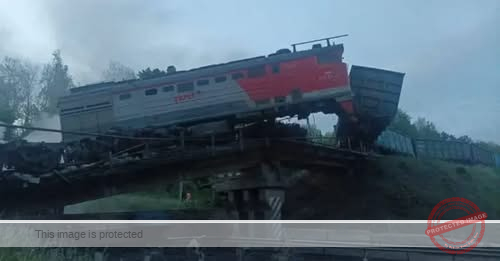
Two major bridge collapses in Russian regions bordering Ukraine have resulted in at least seven fatalities and dozens of injuries, according to official reports. The incidents occurred overnight in Bryansk and the Zheleznogorsk district of Kursk, triggering emergency responses and investigations amid heightened regional tensions.
The first collapse involved a road bridge in Bryansk, which fell onto a moving passenger train, causing multiple heavy trucks to crash onto the train cars. Governor Alexander Bogomaz confirmed that the accident claimed the lives of at least seven people and left at least 71 injured. Dramatic images circulating online show passengers assisting each other out of the wreckage under dark conditions.
Just hours later, another bridge collapsed in the Zheleznogorsk district of Kursk, derailing a freight locomotive. The train caught fire, and the driver sustained leg injuries. Acting Governor Alexander Khinshtein reported that emergency services were actively working at the scene, and he pledged to keep the situation under control. He also shared visuals on social media depicting the overturned locomotive and the damaged bridge infrastructure.
Russian state media are treating both collapses as potential “acts of terrorism,” while Moscow Railway has alleged “illegal interference” as the cause of the Bryansk bridge collapse. The incidents have prompted an immediate investigation by Russia’s interregional transport prosecutor’s office, with additional rescue equipment and lighting deployed for night operations.
The Bryansk bridge incident occurred in the Vygonichsky district while a train was traveling from Klimovo to Moscow. Following the derailment, passengers were evacuated and directed to a nearby station, where Moscow Railway arranged for a reserve train to continue their journey toward Moscow.
These two infrastructure disasters occurred within approximately 100 kilometers of the Ukrainian border, a region experiencing intensified conflict and military operations. The timing and scale of the incidents have fueled controversy and speculation.
A Ukrainian national security official dismissed the incidents as Russian “false flag” operations designed to manipulate international opinion in the lead-up to peace talks scheduled in Turkey. Andrii Kovalenko, head of Ukraine’s National Security and Defence Council’s Centre for Countering Disinformation, accused Russia of attempting to sabotage the negotiations and emphasized that Ukraine had no incentive to disrupt the Istanbul summit.
Russian President Vladimir Putin was reportedly briefed throughout the night on the evolving situation, underscoring the high-level attention given to these critical events.
The context surrounding the collapses is further complicated by ongoing military activity. The Ukrainian Air Force reported intense Russian missile and drone attacks overnight, involving 472 UAV and drone strikes and seven missile launches targeting seven regions. The escalating conflict continues to place immense strain on both sides’ infrastructure and civilian safety.
Images from the bridge collapses reveal the devastating aftermath: twisted metal, overturned train carriages, and damaged bridges, highlighting the destructive impact on transportation routes vital for regional connectivity and commerce.
Emergency responders faced challenging conditions, working through the night to rescue survivors, contain fires, and clear debris. The scale of the accidents necessitated the deployment of specialized rescue teams, lighting for nighttime operations, and coordination among multiple agencies.
The loss of life and injury toll add a tragic human dimension to the already volatile situation along the Russia-Ukraine border. Families of victims and survivors are coping with trauma and uncertainty as investigations continue.
Authorities in Russia have pledged to determine the exact causes of the bridge collapses. Whether due to sabotage, structural failure, or other factors remains under scrutiny. The region’s strategic importance and heightened security concerns mean that the findings will carry significant political and military implications.
This incident serves as a stark reminder of the vulnerabilities of critical infrastructure amid conflict and geopolitical tension. Bridges and railways are lifelines for communities and economies, and their destruction can disrupt essential services, humanitarian aid, and civilian mobility.
As peace talks loom, the bridge collapses inject further complexity into an already fragile diplomatic landscape. The international community watches closely, hopeful for resolution yet wary of ongoing hostilities and provocations.
In conclusion, the twin bridge collapses in Bryansk and Kursk mark a tragic escalation of tensions on the Russia-Ukraine border, with loss of life and significant infrastructure damage. Investigations continue amid conflicting narratives, and the broader conflict remains highly volatile with continued military activity and diplomatic uncertainty.
The post Twin Bridge Collapses Near Ukraine Border Kill Seven Amid Rising Tensions and Investigations first appeared on Trusted and Verified USA News.
